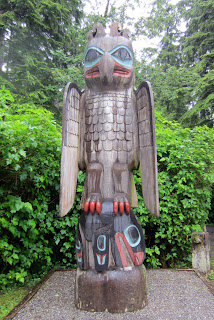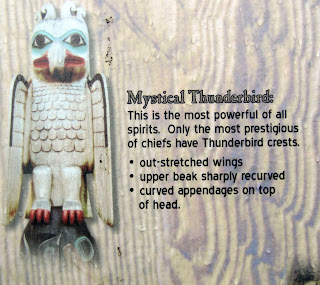Right after that I stopped at the Tongass Historical Museum which collects, preserves, and
interprets material and information pertaining to
the history, art, and culture of Ketchikan and Southeast
Alaska.Check out its website at:
http://www.city.ketchikan.ak.us/departments/museums/tongass.html
It is housed in the same building as the library. The museum cost $2 and was easy to see in
less than 30 minutes.
Here are photos taken of Ketchikan around 1905:
 |
| Town on the waterfront |
 |
| Ketchikan Business District, 1905 |
Fishing was big in Ketchikan:
Fish traps were used to catch fish. Here is a photo taken in 1930 of large stationary ones. For hundreds of years before the Europeans came, the natives used traps on salmon streams, often driving stakes into the river bottom. Late in the 1800s, canneries began to build stationary traps in the mouths of big streams, with pilings to support suspended nets. The government later made that illegal as few of the salmon could escape so the traps were moved elsewhere. They had to be repaired often so divers fixed them.
You can see the headgear the divers worse--this was before scuba diving became official
Many local Alaskans hated the fish traps because they were owned by outsiders and depleted the salmon run for the locals. In 1959, when Alaska became a state, it immediately banned such fish traps.
Above is one of my favorite pictures, of local kids with a large halibut. The photo was taken in 1909.
Here is a cute sign from a cannery:
Here is another photo from the early 1900s with 3 little girls looking at a pet bear cub:
Here is a baby carriage quilt:
Telephone service began in Ketchikan in 1909. This was a typical early phone and was used into the 1950s.
Casper Mather, a Tsimshian carver, made many small totem poles and masks from the 1930s to the 1970s. The photo below was taken in the early 1950s.
The Truman pole on the right below was carved by Mather. The middle one is a beaver, raven, bear pole and the far left one is a Haida Creation Myth pole made in 1962.
There was also a section on airplane service to Ketchikan. The picture of the float plane below was taken in the 1950s.
The cashier gave me
directions to the bus to Totem Bight and told me it was a lovely place, and
that she had gotten married there.
So I walked back to town and took the Blue line bus out to
Totem Bight, a state park with close to 20 totem poles preserved and moved to
the site. The bus is $1 one way (50
cents for seniors if you have correct change) or $2 for the day. The guy I sat next to for part of the way out
moved here 17 years ago. He fishes in season
and paints businesses inside and out at other times. Sometimes the rains keep him for finishing
jobs for days. His father was from this
area and mother originally part Native American from northern Mexico. They met at Seattle College (now University)
and settled in California. He used to
come up with his dad to this area to fish and the boys returned to live here.
This bus has just one driver for the day. He leaves the port area and 45 min after the
hour and leaves Totem Bight at 15 after the hour. On the way back I sat next to a woman that
moved here about 20 years ago too. She
is a cook for the loggers. I said I
didn’t think that there was much logging in the area and she agreed and it was
because of the conservationists in Washington, Oregon, and Colorado, and said
that because of the lack of logging there are fires in Colorado. She was a kick, and was happy to take my bus
pas for the rest of the day. That bus
stops at Walmart on the way out but not on the way back. She said that in winter, the town is reduced
to under 5000 people but I am not sure she is accurate.
Here is the website for Totem Bight: http://dnr.alaska.gov/parks/units/totembgh.htm
 |
| Walking into the park in the rain |
With the growth of non-Native settlements in Southeast Alaska in the early 1900's, and the decline of a barter economy,
Natives moved to communities where work was available. The villages and totem poles they left behind were soon overgrown by
forests and eroded by weather. In 1938 the U.S. Forest Services began a program aimed at salvaging and reconstructing these
large cedar monuments. By using Civilian Conservation Corps (CCC) funds to hire skilled carvers from among the older Natives,
two things took place: young artisans learned the art of carving totem poles, and totems which had been left to rot in the woods
were either repaired or duplicated.
There were nice explanatory signs around the park including this one:
The website shows the major designs on poles. It is definitely worth looking at.
Here are most of the symbols that were explained on a sign at the park. See if you can recognize them in the totem poles that follow. :)
Here are the poles of the park.
:
 |
| Pole 1: Thunder and Whales |
 |
| Pole 2: Eagle Grave Marker |
Pole #3: Man Wearing Bear Hat
Clan House and Pole #4: Wandering Raven
Inside the Clan House:
 |
| Pole 6: Blackfish Pole |
 |
| Pole 7: Land Otter Pole |
 |
| Pole 8: Master Carver |
Down the road by the beach:
 |
| Pole 9: Sea Monster Pole |
 |
| Pole11: Kaat's Bear's Wife with bear prints |
 |
| Pole 12: Kadjuk Bird |
 |
| Pole 14: Thunderers |
Behind the gift shop on an adjacent property, there was Potlatch Park Carving Center. The carvers' were not there, but I could see their work in progress.
 |
| carvers' work area |
There were some unusual bushes growing along the pathway that were filled with white flowers that looked a bit like strawberry flowers. I asked and found out that these were salmon berries. I later tasted a jam made from these berries and it was pretty tasteless (except for the sugar) but the natives used them for many things.
From what I read, they more closely resemble raspberries.
My poncho kept me pretty dry…just got wet feet.
I got back on the boat, picked up my laptop and headed out
again to the library a few blocks away and got a pass to use the internet for
free for a dollar. They asked for a
donation to help remodel the library, so I happily complied.






























1 comment:
Taj Mahal is the most excellent vacationer destinations in India, with its beautiful one. Taj Mahal is One of the Seven Wonders of the World, located at the bank of the Yamuna. Taj Mahal made of pure white marble. Taj Mahal is in Agra city of Uttar Pradesh state. It is built by Shah Jahan in 1652 in memory of wife Mumtaj Begum. Taj Mahal is a UNESCO World Heritage list in 1983.
One Day Taj Mahal Tour by Car
One Day Delhi Tour by Car
Same Day Jaipur Tour by Car
Same Day Agra Tour by Gatimaan Express
Same Day Agra Tour by Shatabdi Express
Thanks and Best Regards
Mobile: +91-9568246666
Email: info@dreamindiavacation.com
Website: www.dreamindiavacation.com
Blog: www.dreamindiavacation.blogspot.com
Post a Comment